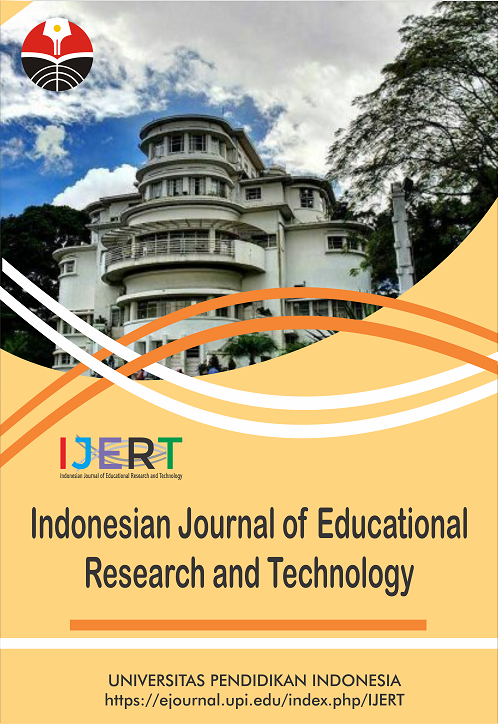Examining Facilitating Condition and Social Influence as Determinants of Secondary School Teachers’ Behavioural Intention to Use Mobile Technologies for Instruction
Abstract
This study examined the social influence and facilitating condition as determinants of secondary school teachers’ behavioural intention to use mobile technologies for instruction in Kaduna State, Nigeria. The study adopted descriptive research of the survey type to 958 teachers in Kaduna State, Nigeria. The findings indicated there was strong relationship among teachers’ social influence, facilitating condition and behavioral intention to use mobile technologies with ANOVA value of F (2,956) 61.53 p < 0.05, F (2,956) 28,786 p < 0.05 and F (2,956) 5.152 p< 0.05, respectively. The study concluded that teachers' social influence and facilitating conditions influenced their behavioural intention to use mobile technologies for instruction. The implication is that there might be an improvement in teaching and learning at secondary school if mobile technologies are integrated into teaching. The study recommended among others, that secondary school teachers should help themselves by making use of mobile technologies for instructional purposes and shift their focus from using them for fun and entertainment to improving instructional delivery.
Keywords
Full Text:
PDFReferences
Abendin, S., Pingfang, D., and Nkukpornu, E. (2022). Bilateral trade in west Africa: Does digitalization matter?. The International Trade Journal, 0(0), 1-25.
Agrawal, J., Patel, R., Mor, P., Dubey, P., and Keller, J. M. (2015). Evolution of mobile communication network: From 1G to 4G. International Journal of Multidisciplinary and Current Research, 3, 1100-1103.
Bruggeman, B., Tondeur, J., Struyven, K., Pynoo, B., Garone, A., and Vanslambrouck, S. (2021). Experts speaking: Crucial teacher attributes for implementing blended learning in higher education. The Internet and Higher Education, 48, 100772.
Chase, T. J., Julius, A., Chandan, J. S., Powell, E., Hall, C. S., Phillips, B. L., and Fernando, B. (2018). Mobile learning in medicine: an evaluation of attitudes and behaviours of medical students. BMC Medical Education, 18(1), 1-8.
Correa, T., Valenzuela, S., and Pavez, I. (2022). For better and for worse: A panel survey of how mobile-only and hybrid Internet use affects digital skills over time. New Media & Society, 00(0), 1-23.
Criollo-C, S., Guerrero-Arias, A., Jaramillo-Alcázar, Á., and Luján-Mora, S. (2021). Mobile learning technologies for education: Benefits and pending issues. Applied Sciences, 11(9), 4111.
Danchikov, E. A., Prodanova, N. A., Kovalenko, Y. N., and Bondarenko, T. G. (2021). The potential of online learning in modern conditions and its use at different levels of education. Linguistics and Culture Review, 5(S1), 578-586.
Ennouamani, S., Mahani, Z., and Akharraz, L. (2020). A context-aware mobile learning system for adapting learning content and format of presentation: design, validation and evaluation. Education and Information Technologies, 25(5), 3919-3955.
Hirata, Y. (2021). Are Japanese university students ready for remote language learning?. Interactive Technology and Smart Education, 19(1), 75-86.
Jeon, J. (2022). Exploring a self-directed interactive app for informal EFL learning: a self-determination theory perspective. Education and Information Technologies, 24(2) 1-21.
Kasri, R. A., and Yuniar, A. M. (2021). Determinants of digital zakat payments: lessons from Indonesian experience. Journal of Islamic Accounting and Business Research, 12(3), 362-379.
Luomanen, J., and Alasuutari, P. (2022). The rising social media and declining alcohol use: the case of Finnish teenagers. Contemporary Drug Problems, 49(1), 1-15.
Manimekalai, J. (2013). Behavioural Intention to Adopt Mobile Technology among Tertiary Students. World Applied Science Journal. 22(9), 1262-1271.
Oldeweme, A., Märtins, J., Westmattelmann, D., and Schewe, G. (2021). The role of transparency, trust, and social influence on uncertainty reduction in times of pandemics: empirical study on the adoption of COVID-19 tracing apps. Journal of Medical Internet Research, 23(2), 1-17.
Sadri, A. M., Ukkusuri, S. V., and Ahmed, M. A. (2021). Review of social influence in crisis communications and evacuation decision-making. Transportation Research Interdisciplinary Perspectives, 9, 100325.
Walrave, M., Waeterloos, C., and Ponnet, K. (2021). Ready or not for contact tracing? Investigating the adoption intention of COVID-19 contact-tracing technology using an extended unified theory of acceptance and use of technology model. Cyberpsychology, Behavior, and Social Networking, 24(6), 377-383.
Zhang, K., Wang, J., Liu, T., Luo, Y., Loh, X. J., and Chen, X. (2021). Machine Learning‐Reinforced Non-invasive Biosensors for Healthcare. Advanced Healthcare Materials, 10(17), 2100734.
DOI: https://doi.org/10.17509/ijert.v3i1.44720
Refbacks
- There are currently no refbacks.
Copyright (c) 2022 Universitas Pendidikan Indonesia

This work is licensed under a Creative Commons Attribution-ShareAlike 4.0 International License.







.png)




